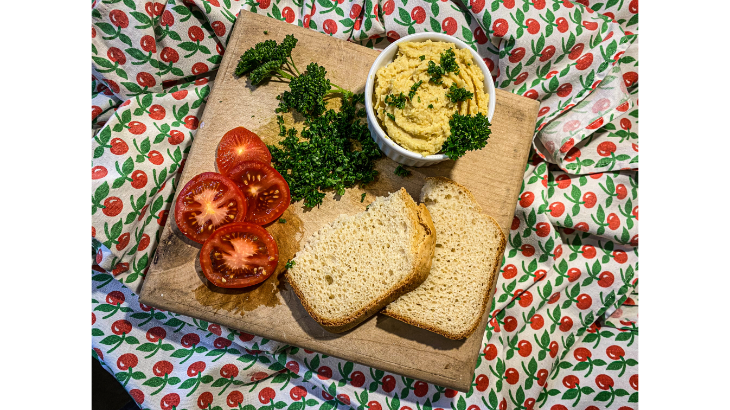Hummus - or Humous?

Forty or so years ago, when Findus Frozen Pancakes were a staple for the mythical average family, because they were quick if you were in a rush, who could have imagined that hummus would regularly find its way into the British shopping basket?
A quick snack, great for dipping carrots or as a filling for sandwiches, it is also easy to prepare, and the home-made variety is economical, has no artificial preservatives, and the finished article can be varied to accommodate taste.
Essential ingredients are very basic – chickpeas, garlic, olive oil, a splash of balsamic vinegar or freshly squeezed lemon, and salt and pepper. You will need a food processor, or a very efficient stick blender to complete the process.
As always, I advocate using freshly prepared chickpeas, in part because it is a much cheaper option, but above all because the quality will be so much better than tinned ones, and you can cook dried chickpeas to the desired texture.
If you’re preparing them from dry chickpeas need to soak for about 6 – 8 hours prior to cooking. After this, drain and rinse them under cold running water for a few seconds, put them in a large pan, add half a dried bay leaf and plenty of water, and bring to the boil. Don’t add salt to the water, as this is likely to impede the softening process.
Once they have reached boiling point, turn the heat down, put a lid on the pan, and leave to simmer gently for around 45 minutes. Next, fish a couple of peas out and test them to see if they are cooked to your liking – we prefer them slightly al dente, but they need to be soft enough to make a smooth purée for the hummus.
Remove the bay leaf and leave the peas in the cooking water to cool. Don’t discard the liquid – you may need some of it for the preparation of the hummus, and the rest can be frozen for use as stock in a stew or soup.
At the risk of repeating myself from previous recipes, always use the best olive oil your purse will allow for dishes where the oil will be consumed without cooking. Alternatively, use a good quality rapeseed oil, which might be slightly less pricy.
Many of the less expensive oils have a bitter aftertaste, which is masked when cooked, but in hummus, the taste of the oil is an important factor in the finished dish.
Once the chickpeas are cool, drain them and place them in the food processor, or a fairly deep pudding basin if you are going to use a stick blender. You need enough depth that the peas won’t escape while you are blending them, but the base of the bowl shouldn’t be too wide, or it will be difficult to get the mass of the peas together while you’re wielding the stick blender. A food processor is much easier, but I have used both methods and both “work”, though the finished product is slightly different.
You will need:
400g drained cooked chickpeas
1 tablespoonful or so of reserved cooking liquid from the peas.
3 cloves garlic or more, if you like
200 ml best olive oil
Ground rock salt and black pepper to taste
Splash of balsamic vinegar or freshly squeezed lemon juice
Pulse the chickpeas until they are all broken up, then crush and add the garlic. Continue blending the mixture until it looks mashed. Now start to add the olive oil, a trickle at a time, as if making mayonnaise, continuing to pulse as you go. The objective is to blend in the oil, and it should incorporate relatively easily. You will not know exactly how much oil to use until you have checked it yourself for flavour and texture. Taste the mix from time to time, and when you feel happy with it, blend for another minute or two and check again. If it is too stiff, add a little of the cooking liquid, then the salt and pepper, and a splash of lemon juice or balsamic vinegar, taking care not to overwhelm the flavours of chickpeas and oil. Pulse for another few moments, then set it aside in the fridge to cool.
If you decide to use tinned chickpeas, don’t discard the liquid when you open the can, you can substitute this for the cooking fluid. After you’ve drained the chickpeas, run them under a cold tap for a moment or two, then continue as above.
Garnish with chopped fresh herbs, and serve with toast and oil for dressing. Et bon appétit!
